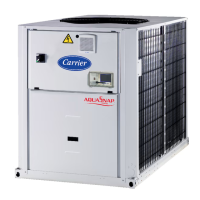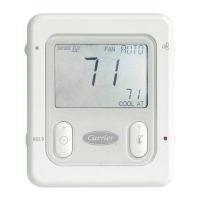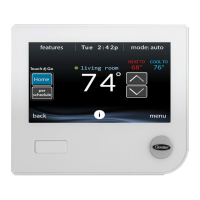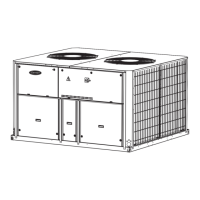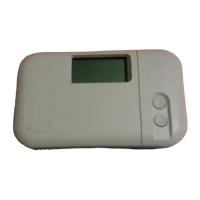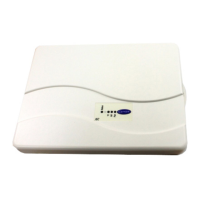3.1 - Control boards
Each circuit is by default tted with one SIOB board used to
manage all major inputs and outputs of the controller.
Options, such as EMM or free cooling, require the installation of
additional SIOB boards. Units with seven or eight xed speed fans
are tted with AUX2 board.
All boards communicate via an internal LEN bus.
3.2 - Electrical box
The electrical box includes all boards controlling the unit and the
user interface (SmartView).
The main board continuously monitors the information received
from various pressure and temperature probes and accordingly
starts the program that controls the unit.
The unit is equipped with the SmartView user interface. The number
of boards available in the electrical box depends on the number of
selected options.
SIOB A
board
Drive
breakers
Fan contactors
& breakers
Main
breakers
SIOB B board
+ EMM SIOB board
+ Free Cooling SIOB board
+ AUX2 board
Main switch
Electrical transformer
Compressor safeties
3.3 - Touch panel connections
Connections are located on the bottom and the right side of the
controller.
■ The control offers communication protocols such as LEN, CCN
(Carrier Comfort Network), Modbus, or BACnet.
■ It is possible to enable and disable end of line resistors via the
System menu (see section 5.6).
■ One Ethernet ports allow for TCP/IP communication or BMS
(Building Management System) connection.
Connections on the bottom side of the controller
3 - HARDWARE
3.4 - Power supply to boards
All boards are supplied from a common 24 VAC supply referred
to earth.
CAUTION: Maintain correct polarity when connecting the
power supply to the boards, otherwise the boards may be
damaged.
In the event of a power supply interrupt, the unit restarts
automatically without the need for an external command. However,
any faults active when the supply is interrupted are saved and
may in certain cases prevent a given circuit or the unit from
restarting.
3.5 - Light emitting diodes on boards
All boards continuously check and indicate the proper operation
of their electronic circuits. A light emitting diode (LED) lights on
each board when it is operating properly.
■ The red LED ashing for a two-second period indicates correct
operation. A different rate indicates a board or a software failure.
■ The green LED ashes continuously on all boards to show that
the board is communicating correctly over its internal bus (LEN
bus). If the green LED is not ashing, this indicates a LEN bus
wiring problem or a conguration issue.
7
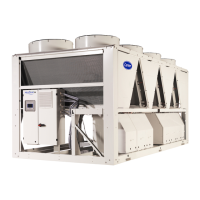
